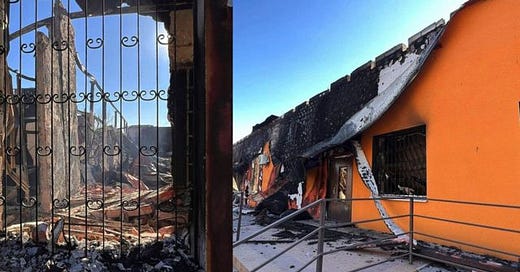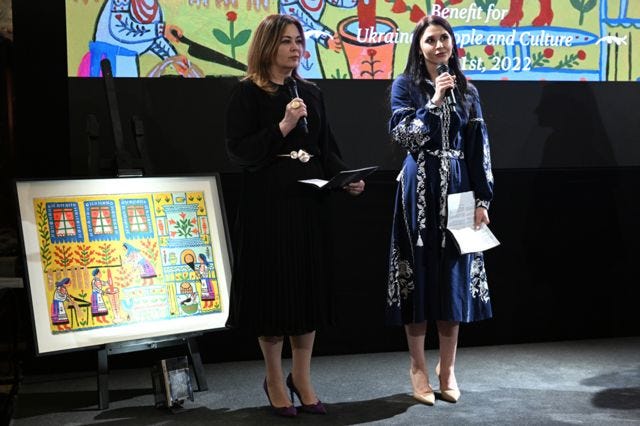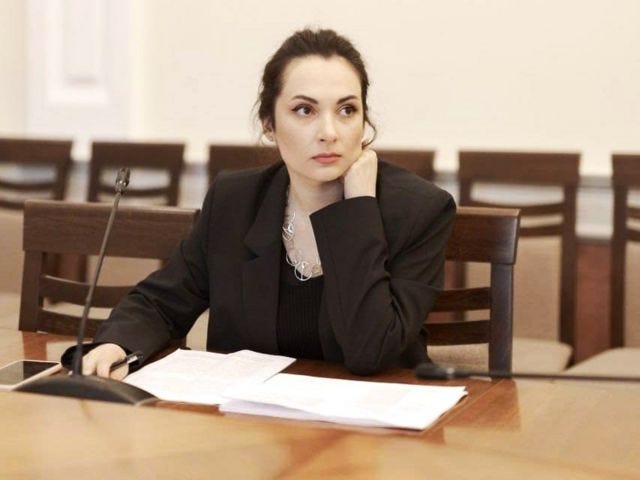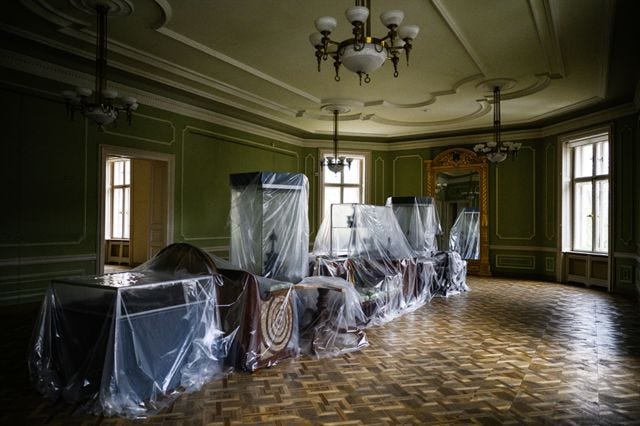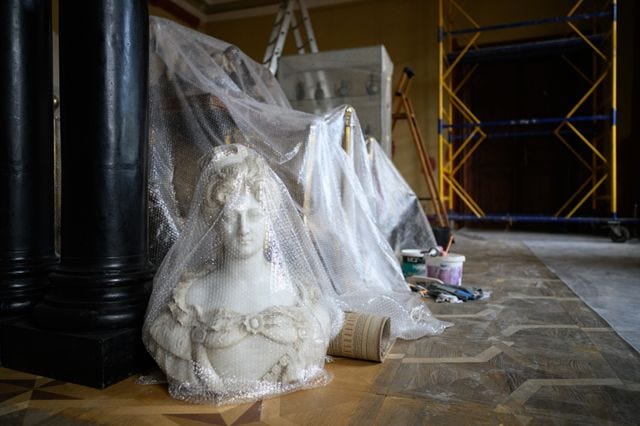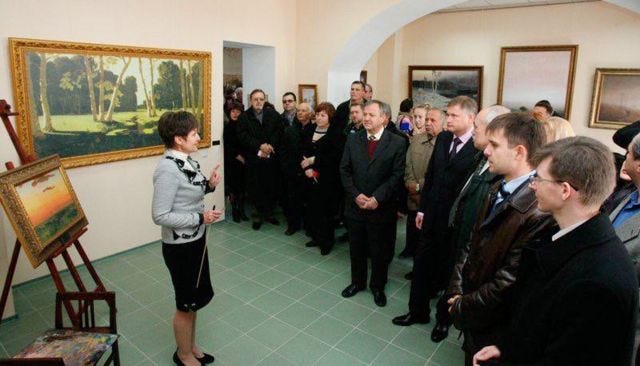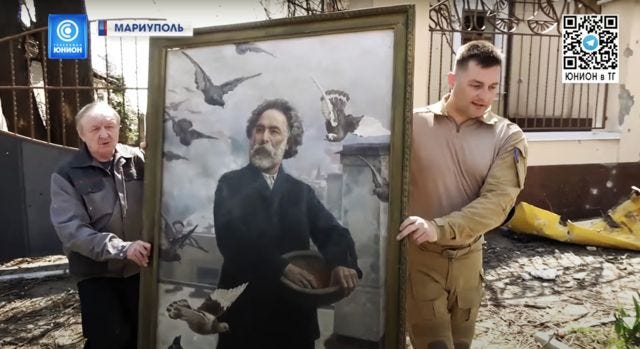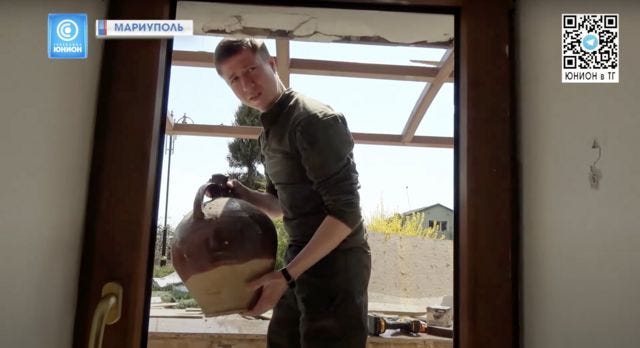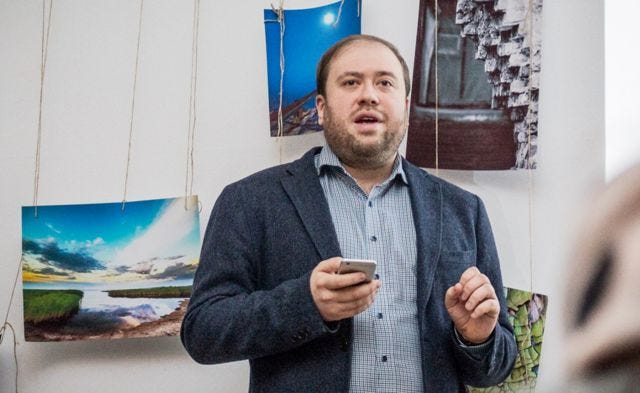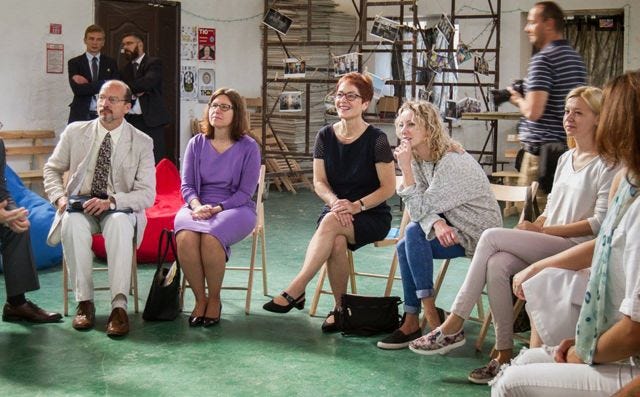War on culture. How Russia is destroying museums and taking art from Ukraine
Russia’s war in Ukraine isn’t just taking the lives of Ukrainians — it’s erasing their cultural heritage, too.
By Anastasia Soroka and Grigor Atanesian
Photo from the private archive of Igor Nikolaenko: Ivankiv Museum of History and Local Lore, which burned down in the first days of war.
Russia’s war in Ukraine isn’t just taking the lives of Ukrainians — it’s erasing their cultural heritage too. Bombs are destroying museums, libraries, churches and mosques, theatres and universities.
Among the items taken away by Russian forces from occupied territories are paintings by Aivazovsky and Kuindzhi, Scythian gold and manuscripts. Museum staff have been abducted too.
Museum employees, gallery owners and civilians have been telling the BBC how they saved Ukrainian and Russian modern and classical artworks, and escaped with their lives.
A museum in flames and “Wagner” captivity
On 26 February, a shell hit the local history museum in the small town of Ivankiv, eighty kilometres northwest of Kyiv. At the start of the war, columns of Russian soldiers marched through the settlement on their way to fierce fighting in Borodyanka, Bucha and Hostomel.
Ivankiv came under Russian occupation in the very first days of the war, emptied of its Ukrainian border guards, military and police. But local residents are at a loss to understand why the local museum, situated on the outskirts of town near a residential neighbourhood, river and park, came under fire. Nothing else in the area was damaged.
The shell hit the museum roof and a fire broke out. No-one heard the explosion, says local resident Igor Nikolaenko, a 33-year old fitness instructor, perhaps because of other explosions nearby.
Nikolaenko recounts how he and other local residents watched from the municipal park as Russian military equipment passed through the town centre. He saw the shell coming from the direction of the bridge where the equipment was headed. Turning round, he noticed there was white smoke rising over the town museum, which was located deep in the park’s grounds.
“I run up to it and see seven or eight people standing there,” Igor recalls. “They tell me a shell hit the museum, and it’s on fire.”
Helped by a young man whose name no-one knew, he and museum caretaker Anatoly Kharitonenko rushed to save the exhibits from the fire.
The museum was locked and the guard had no keys, so the men decided to break the window bars to get inside. “We were just lucky that the workmen were —how can I put this?— cack-handed,” Igor recounted. “They’d only attached the window grating with self-tapping screws in the insulation material. We pulled out the metal bar, smashed the glass with it, then opened the reinforced plastic window and climbed inside.”
Ivankiv is surrounded by forest and numerous small villages. Its local history museum is the only one in the area and Igor, who was born in the town, has visited it almost every year since he was at school.
A couple of years before the start of the war, the museum was fully restored. Its exhibits included traditional costumes, ceramics and other cultural artefacts from the Polesia region, as well as paintings by local artists, World War II weapons and even a mammoth skeleton.
But the museum’s most valuable exhibits were its collection of canvasses by Maria Prymachenko, a representative of ‘folk primitivism’ known for her vibrant and colourful folklore-inspired paintings populated by fairytale creatures, chicken-footed people and fantastical flowers with human eyes.
Picasso described Prymachenko’s work as an ‘artistic miracle’. For others, her paintings echo the horrors of the 20th century — horrors such as Stalin’s great famine, in which more than three million Ukrainians lost their lives.
One of Ukraine’s most beloved artists, Prymachenko was self-taught. She spent her entire life in Bolotnia, a village located on the same small river as Ivankiv. Prymachenko’s work was donated to Ivankiv museum by her family, and it was her paintings which were rescued first from the fire: twelve canvasses, packed and stored in a separate room. The caretaker’s wife had shown where they were.
“We pulled the pictures out first and passed them to the people outside,” says Nikolaenko. “Then I looked – we still had some time, so we started to carry out the rushnyk embroideries, antique wooden objects, and various WWII documents. It took about twenty minutes to get it all outside.”
But Igor is distraught that so much was lost. “It’s our cultural and global heritage after all. That’s why I told everyone we had to save as much as we could.”
The fire spread quickly. The building filled with smoke and the ceiling was on the verge of collapse. After the fire, only the retaining walls remained.
“It’s such a shame we ran out of time,” the fitness instructor sighs. “It’s just such a shame. There were so many valuable things there that can never be restored.”
Ivankiv remained under Russian occupation for more than a month, until the troops left town on 1 April. According to Nikolaenko, the units included mercenaries from the Wagner group, a private military company established after the start of the war in Donbass in 2014.
When asked by the BBC how he knew there were Wagner mercenaries based in the town, Nikolaenko hesitated a little. “Well…,” he replied, “…it’s just that they held me captive for two days.”
Igor Nikolaenko was taken prisoner during the first days of the occupation in late February. He was cycling with a friend to the neighbouring village of Kropyvnya to help a friend’s family trapped there with a young child. The Russian mercenaries mistook the two men for Ukrainian spies.
“We had no phones, no walkie-talkies, no knives,” Nikolaenko explained. “We thought we’d be okay … but it didn’t fly.”
The men were taken to the village of Rozvazhiv, located 17km from Ivankiv.
“We were held for two days,” he recalls. “They fired their guns past our heads, injured us, beat us up a little.” He says that the soldiers introduced themselves as members of the Wagner Group. It was Nikolaenko’s father who persuaded them to release the two men.
As the war was raging in Ukraine, The Venice Biennale was getting under way in Italy. Among the exhibits in the main programme was a painting by Maria Prymachenko. And at an auction in the city another of her canvasses was sold for 110,000 euros, the BBC was told by the foundation set up by the artist’s family.
According to the artist’s granddaughter, Anastasia Prymachenko (pictured right), this Prymachenko painting was sold at a Venice auction for the sum of 110,000 euros. © Getty Images
It’s unclear whether the destroyed Ivankiv museum will ever be rebuilt. But the Prymachenko foundation plans to invest the money raised at the Venice auction in the construction of a new museum dedicated to the artist’s work.
First days of chaos
It wasn’t just provincial museums that were caught off-guard by the invasion. Curators, gallery owners and private collectors complained to the BBC that their collections weren’t ready for evacuation. In truth, no-one was ready.
Museum curator Yana Barinova, who worked as director of Kyiv’s Department of Culture, remembers the first day of war. “We were woken by sirens,” she said. “Those awful sirens – I’ve only ever heard sounds like that in horror films. Psychologists must have had a hand in inventing them…those sounds instil fear.
Photo from the personal archive of Yana Barinova: Yana Barinova was head of the capital’s department of culture when war broke out
Yana recalls how she took her daughter, stuffed two rucksacks full of their possessions, and was at work by eight in the morning. Not all her colleagues attended the meeting. For some, Kyiv’s government quarter was simply too dangerous.
Their fears, as it happens, were not unfounded, and it wasn’t just missile strikes that were a threat. As Ukraine’s president Volodymyr Zelensky and his colleagues later recalled, Russian soldiers twice attacked the presidential residence on Bankova street after landing in Kyiv.
According to Barinova, culture ministry employees had no pre-approved, centralised plans to evacuate works of art at the time of the invasion. She describes how she was approached at a British embassy reception in early January by Olesya Ostrovska-Lyuta, Director of Mystetskyi Arsenal Art Museum Complex in Kyiv. By then, Western intelligence agencies were openly warning of a forthcoming Russian invasion.
Yana recalls her colleague’s question: “Are you drawing up plans for evacuation?” She also remembers the smile she gave as she replied that yes, plans were being developed, although the evacuation had not been prioritised at Ministry of Culture meetings. And without the ministry’s permission, no cultural treasures could be evacuated.
When the war began, few museums were prepared for the evacuation of their treasures. The photo shows Potocki Palace in Lviv, one of the branches of the Borys Voznytsky National Art Gallery in Lviv. © LEON NEAL/GETTY IMAGES
“The first ten days of war were complete chaos,” recalls Barinova. She estimates that the department had dozens of theatres and museums within its remit – around 75 cultural institutions in total.
Barinova asked the museums to draw up a short list of their most important artefacts, but in return received lists containing hundreds of items. It became clear that many of the collections would simply be too dangerous to evacuate. They might get damaged or looted along the way, or be hard to get back once they’d crossed over the border. There was also a lack of security for their transportation.
“We had to conduct negotiations regarding the items we’d chosen to evacuate: who would receive them, how much space there was, what types of agreements to draw up and with whom,” Barinova says.
“Each director made decisions based on the collection and infrastructure of their own museum. Most had basements, so the pictures were taken down, packed in doorways, their glass panes taped up. For those first two weeks, many directors heroically chose to stay in their museums even at night.”
Works of art packed away in Lviv’s Potocki Palace. They were only successfully evacuated in late April/early May. © Getty Images
Another task was to evaluate sites damaged by shelling. Even reaching these sites to assess the damage and take an inventory was often extremely challenging. Barinova recalls how her driver was forced to queue for four hours just to refuel his car.
Ukrainian-American art critic Konstantin Akinsha was one of the first to speak out about the need to evacuate museums.
“In a full-scale Russian invasion, practically all significant museum collections would be in danger,” Akinsha warned in a column for the Wall Street Journal published one week before the invasion.
He decided to raise the issue publicly when he learnt from conversations with colleagues in Ukraine that no evacuation was being prepared. This was partly due to the authorities’ reluctance to spread panic.
“At that time president Zelensky was engaged in a public controversy with Biden and the Americans, claiming they were predicting an invasion that was not taking place,” Akinsha says.
He believes there was also a failure to learn lessons from the destruction and unlawful transportation of cultural treasures in Donbass after 2014: “It was already clear what might happen, but no-one took the time to draw up serious plans for evacuation or conduct training and the like.”
According to Akinsha, a rare example of good preparation was the Odesa Fine Arts Museum, whose collection includes Ukrainian and Russian cultural masterpieces ranging from icons to canvasses by Repin, Levitan, Vrubel and Kandinsky.
Artist Oleksandr Rojtburd, who ran the museum for several years, had gathered together a group of sponsors composed of local entrepreneurs. These connections later proved useful: sponsors supplied all the equipment and materials the museum required. Alexandra Kovalchuk, who took charge of the museum after Rojtburd’s death, appealed to Odesa’s artists for help packing and transporting the artefacts to safe locations for temporary storage.
“No-one can ever be 100% prepared for such a full-scale war”
Ukraine’s Ministry of Culture is responsible for recording overall losses. At the time of writing, its list comprises 335 sites, including 29 museums, 27 libraries and 116 churches and cathedrals.
As of 16 May, UNESCO had been able to independently verify damage to 133 of these. In reality, though, the scale of destruction may be far greater.
Also damaged by shelling were Kharkiv’s art museum, its Korolenko State Scientific Library and Mykola Lysenko Academic Opera and Ballet Theatre, Chernihiv Regional Art Museum, Mariupol Museum of Local Lore, the memorial museum of the philosopher Hryhorii Skovoroda, Sumy Theological Seminary, the Holy Mountains Lavra of the Holy Dormition and Vorontsov Palace in Odesa.
Worst affected were the Donetsk, Sumy and Kyiv regions, and the towns of Kharkiv and Chernihiv.
Ukraine’s Ministry of Culture informed the BBC that it had undertaken “steps and information-gathering” on the eve of war in late 2021 and the winter of 2022 for the evacuation of works of art. It did not, however, specify the preparations involved, citing security considerations.
Responding to the lack of preparedness in many cultural institutions for the onset of military operations, the press service of Ukraine’s Ministry of Culture observed that “no-one can ever be 100% prepared for such a full-scale war.” “The Ministry could not physically relocate such sites as the Holy Mountains Lavra of the Holy Dormition, the National museum of Hryhorii Skovoroda, the Vorontsov Palace in Odesa or Lysychansk multidisciplinary gymnasium,” the agency added in a statement.
The decision to evacuate works of art was made on 24 February, when martial law was imposed in Ukraine. However, local decision-making was hampered by Russian strikes throughout the country and by the rapid advance of Russian forces on several fronts, the Ministry of Culture told the BBC.
“Α large number of artefacts were nonetheless successfully evacuated,” concluded Ukraine’s Ministry of Culture. “However, some areas were unfortunately occupied very rapidly or came under intense shelling, which from the outset made evacuation impossible to achieve.”
The list of damage mainly consists of places of worship – primarily Orthodox churches, some belonging to the Ukrainian Orthodox Church of the Moscow Patriarchate, and also of other faiths.
Among the latter is Ukraine’s largest synagogue – Kharkiv Choral Synagogue, built in 1913, which was used in the first days of war as a shelter for the local Jewish community. The Jerusalem Post reports that in March the synagogue’s windows were blown out by a blast from a Russian rocket strike.
Just a few days later, in the same town, a Russian shell struck the roof of a yeshiva – a religious school belonging to the Jewish community. According to the rabbi, it failed to explode and no-one was hurt.
“The keys are all I have left”
Tatyana Buli, head of Kuindzhi Art Museum in Mariupol, found out from the Viber app that paintings had been removed from her museum’s collection and transported to the self-proclaimed DPR.
According to media reports, the museum was also destroyed by an airstrike in late March. Tatyana, however, could not verify this information in person. Neither she nor her museum colleagues were able to reach their place of work after the city’s bombing commenced.
Tatyana left Mariupol on 15 March, after “three weeks of bombing, blockades and lack of food and water.” The museum director took with her just two bags of personal belongings and a rucksack containing documents.
“After the onset of cold weather and the blockade, the hunger and the constant bombings, I became very sick and was scarcely able to leave my apartment,” Buli recalls. She describes how one shell hit their apartment building, killing six of its residents. The neighbouring district was completely destroyed, leaving behind only charred ruins.
With the help of friends, Tatyana was able to reach the town of Uman, travelling along roads strewn with bricks, concrete and pipes. From there she joined her son near Kyiv. Since then, Buli has been trying to obtain information on the fate of the museum she has run for the past twelve years.
Kuindzhi museum, a branch of Mariupol Museum of Local Lore, opened in 2010 in a restored two-storey Art Nouveau building dating back to the early 20th century. The ground floor housed a permanent exhibition of paintings and artefacts linked to the Mariupol period of Kuindzhi’s life – a Greek Gospel of 1811, nineteenth century icons, and antique furniture. The first floor was set apart for temporary exhibitions.
But the museum’s collection didn’t just contain the work of Kuindzhi, one of Mariupol’s most famous native artists. It also housed paintings by Kuindzhi’s teacher Aivazovsky, by Russian landscape artists Dubovsky and Kalmykov, and by Marchuk and Yablonska – Ukrainian artists of the sixties era. Some of these works were stored in the Kuindzhi museum itself, others in the archives of the local history museum.
Photo from the personal archive of Tatyana Buli: Tatyana Buli in Arkhip Kuindzhi Art Museum, which she ran for 12 years.
Tatyana proudly recounts how her small museum received guests from England and France, exchanged paintings with other Ukrainian museums, and put on Ukraine-wide exhibitions in cooperation with Ukraine’s National Union of Artists.
“We became a notable venue in the town,” says Buli, visibly perking up at the memory. “We ran numerous fascinating projects and received a lot of distinguished guests.”
After leaving Mariupol, Buli for a long time believed the museum was gone – turned to ashes by an air strike. That, at least, was what she read in the media and was told by friends of friends who, like her, had managed to escape the bombarded city.
Then one day at the end of April, she saw footage posted online of her boss Natalya Kapustnikova, director of Mariupol Museum of Local Lore, in the company of Russian soldiers. Kapustnikova was removing artefacts from the museum basement, which they’d managed to enter through a broken window. But while it was claimed in the clip that the basement keys had been handed in to the central commandant’s office, Buli told the BBC they had always been in her possession.
“From what I heard, the window was forced open and they got inside. The thing is, I’d actually taken the keys with me when I left. The keys were a part of me, so to speak. They were all I had left of the museum. So I didn’t leave them with anyone.”
Buli says she personally hid valuable display exhibits in the museum’s basement during the first days of war. “The things I hid survived. But they were handed over to the occupiers all the same,” she sighs.
Russian journalists pull a portrait of Arkhip Kuindzhi, painted by his pupil Grigory Kalmykov, from the museum basement.
The artworks that were taken include Kuindzhi’s paintings ‘Red Sunset’, ‘Autumn’ and ‘Elbrus’, Aivazovsky’s ‘At the Caucasian Shore’, a deathbed portrait of Kuindzhi painted by his pupil Grigory Kalmykov, a bust of the artist by Beklemyshev, and antique icons and books. In the film featuring Russian soldiers it was asserted that the insured value of ‘Red Sunset’ alone is $700,000.
But it’s unclear what happened to the part of the collection housed in the regional history museum. The museum burned down, and Tatyana believes the display exhibits were lost at the time. Her voice starts to tremble. “I don’t know what happened to it [this part of the collection], but I think it must be something terrible, something irreversible.”
Tatyana’s only comfort is that her own museum, despite rumours of an airstrike, has remained standing.
“Thank God it didn’t burn down,” the museum director sighs. “I couldn’t see the complete photograph, but I do know the roof was damaged. And I heard from witnesses that the first-floor wall collapsed on one side in the direction of the terrace. We have wonderful terraces,” she adds, fondly. “They’re so comfortable, with a view overlooking the Sea of Azov.”
Buli says that her escape from Mariupol, along with the fate of the museum, have had a permanently detrimental impact on her health. She spoke to the BBC from the neurology department of a Kyiv hospital.
Expropriation
Local pro-Russian publications assert that around two thousand artefacts were removed from Mariupol’s museums. Spokespeople at the Donetsk museum have confirmed that they are in temporary possession of some of the artworks, which will be returned to their museums of origin on request.
Footage shown on Russian television, in which Russian journalists and soldiers are seen removing valuable items stored in the basement of Kuindzhi museum. According to Ukraine, the removal of artefacts from Mariupol to occupied Donetsk is “theft”.
Ukrainian authorities have described this transportation of works of art from Mariupol to Donetsk as “theft”. According to Ukraine’s Minister of Culture Oleksandr Tkachenko, the exhibits are being taken to Donetsk for valuation before being sent on to Moscow.
Art critic Konstantin Akinsha called the removal of works of art from Mariupol “the first systematic, intentional looting of a museum collection in Ukraine since the start of the war.”
It later emerged that a collection including Scythian gold had also been taken to Donetsk from the Museum of Local History in Melitopol.
Can these actions be considered illegal trafficking? UNESCO has given no clear answer to this question, although it assures the BBC that it is carefully investigating all reports of this nature.
A few years ago, the head of UNESCO proposed the use of the term ‘cultural cleansing’, which she understood not only as the destruction of cultural heritage, but as a culturally or religiously-based violation of human rights or attacking of schools and journalists.
This definition was proposed in 2015, when jihadists were engaged in destroying several Middle Eastern and African cultural monuments ranging from Syria’s Palmyra to Timbuktu in Mali. Russia’s two main museums, the State Hermitage and the Pushkin Museum, were unanimous in condemning the destruction at the time.
Today, however, as the Russian invasion destroys cultural sites and removes collections from occupied Ukrainian territories, both institutions remain silent.
It isn’t just art that’s being taken. After the occupation of Melitopol, Russian forces abducted local history museum director Leila Ibrahimova. She later described how she was taken from her home and interrogated by armed men. After her release she was able to escape to Ukrainian-controlled territory.
Ukrainian authorities have reported the kidnapping of a second employee from the same museum: 60-year old Galina Kucher. In April, the director of Osypenko local history museum was also kidnapped, while authorities in Kherson region have reported the abduction of a school principal. The BBC has no information on the present whereabouts of these individuals.
“Gays and lesbians under Biden’s patronage” – a bomb shelter in a centre of contemporary art
One victim of the 2014 war in Donbas was Izolyatsia, Donetsk’s only contemporary art centre, which was converted by DPR separatists into a prison and place of torture. The centre’s collection has remained in separatist-controlled Donetsk.
In 2022, the same fate was suffered by Platform TU, a creation of political analyst Konstantin Batozsky and curator Diana Berg, who fled from their native Donetsk to Mariupol along with thousands of other political refugees.
In Mariupol they began to participate in the region’s cultural development, obtaining international grants, finding premises, organising exhibitions, concerts, art residencies and architectural residencies, and collecting works of art.
Platform TU: Konstantin Batozsky giving a speech in Mariupol, 2016
The platform’s projects addressed acute social issues including gender-based violence, the environment, and discrimination against the LGBT community and people with disabilities.
“It was important for us that people in Ukraine know what Mariupol is,” explained Batozsky. “We wanted them to think of it not just as the hunting ground of Akhmetov [a Ukrainian Oligarch], but as a city with a wonderful seaside and culture. It’s a distinctive, multinational, multicultural city where the Greco-Ukrainian diaspora meets Tatar and Ukrainian culture, creating a symbiotic community that was able to withstand the ‘Russian World’ back in 2014…. and can withstand it again.”
According to its website, TU platform works in this “conservative and paternalistic” city to promote freedom and rights through culture and contemporary art.
“It was the only centre of its kind,” says Batozsky of his brainchild. “There was nothing else like it in Mariupol.” He recalls with pride the grants given to the centre by the United States and the European Union, as well as a visit by the American ambassador: “Everyone who came to Mariupol visited TU.”
Platform TU: US Ambassador to Ukraine Marie Yovanovitch during a 2016 visit to the TU platform
As was the case with Izolyatsia, TU’s collection could not be evacuated, and the art centre’s final reincarnation was as a bomb shelter.
“People fled Mariupol in a single day. They were in shock,” says Batozsky. “Nobody took anything from TU. When your life is under threat, that’s the last thing you’re thinking about.”
“And now Channel One Russia is filming humour segments about it,” he adds, referring to a television programme broadcast on 26 April. Although TU was not mentioned by name in the film, Batozsky immediately recognised his centre, which the film described as an “organisation representing non-traditional orientations – that’s to say gays, lesbians and whatever else you might put in that category.”
The film asserted that the centre was “practically under the direct patronage of the US President and Congress,” accompanying the statement with images of a satanic pentagram and rainbow-coloured calendar.
A second Rotterdam
After war broke out, having already warned of the need for evacuation, Akinsha began documenting the destruction of Ukraine’s cultural heritage.
“Russia’s system of war is to indiscriminately bomb urban spaces, destroying important sites in the process,” said the art critic. “It’s a second Rotterdam,” he added, referring to the historic centre that was completely destroyed by the German air force in 1940.
“You get the impression that the Russian army has never heard of international conventions, not to mention such trifling considerations as the protection of cultural property. They don’t even know that the destruction of cultural heritage is a war crime.”
Cultural sites are protected by several international treaties. As civilian sites they’re protected under the Geneva Conventions, which regulate the conduct of armed conflict. The 1954 Hague Convention, meanwhile, gives separate protection to cultural property. Russia and Ukraine are signatories to both these agreements.
Meanwhile the Rome Statute, which established the International Criminal Court in The Hague, identifies intentional attacks on cultural monuments as war crimes.
According to political analyst Batozsky, this destruction of cultural heritage sites is not a mere by-product of war, but rather a deliberate policy implemented by Russia’s armed forces.
“The destruction of cultural memory is an entirely conscious policy on the part of the occupiers,” he asserts. “It’s the first thing they do. The destruction of culture is a war crime, and it’s entirely deliberate. They loot. They do everything they can to ensure these assets can never be restored.”
According to Yana Barinova, former head of Kyiv’s department of culture, each case should be considered on an individual basis. While the destruction of some sites may have been planned, in other instances it might be accidental. For example, she views the Russian strike on the Mariupol theatre in whose ruins up to 600 people may have perished as deliberate, whereas the broken windows of Kyiv’s Mala opera house are more likely to have been unintentional: “I don’t think they were given the task of wiping all museums from the face of Ukraine. That’s not what we’re observing – as long as some are still standing.”
Barinova does, however, agree that one of the aims of Russia’s forces is to destroy Ukraine’s cultural memory, since cultural heritage is the foundation of any political nation.
“In their view, we’re just an appendage to the Russian Empire. That means we have nothing of our own,” she explains, analysing Moscow’s logic. “And anything we do possess must be destroyed as though it never existed.”
A museum of war
On 17 February, one week before the war started, Kyiv’s authorities launched discussions regarding a new project: a museum about Russia’s war against Ukraine. There’s an attempt in Ukrainian society to make sense of the tragedies of recent years, Barinova said at a meeting of public figures and war veterans in Donbas.
According to Barinova, the project’s aim was to prepare the “spiritual matrix of the country’s revival,” based on historical memories formed through the eight years of hostilities in eastern Ukraine.
There were plans to locate the museum on the territory of Kyiv Fortress – a place whose walls, moats and sconces were built and rebuilt over thousands of years by Kyivan and Lithuanian princes, Zaporizhian Hetmans and Russian emperors ranging from Yaroslav the Wise to Bohdan Khmelnytsky, Ivan Mazepa and Nicholas I.
But the project never got beyond the first meeting. Within just a week, Russia had invaded Ukraine.
“The Museum of War is just a prophetic project now,” muses Barinova. “What else is there to say?”
Read this story in Russian here.
Translated by Camilla Yermekbayeva

